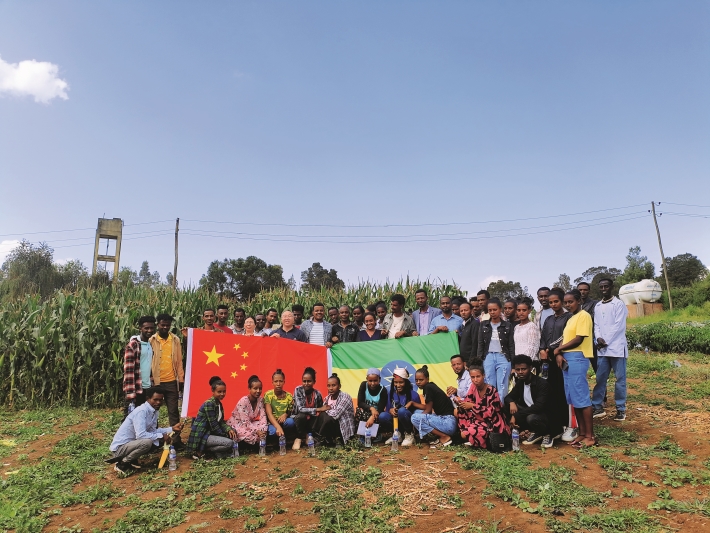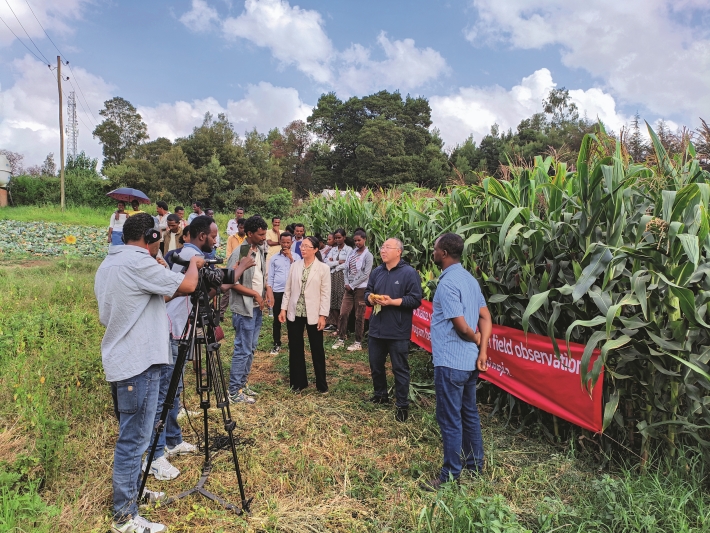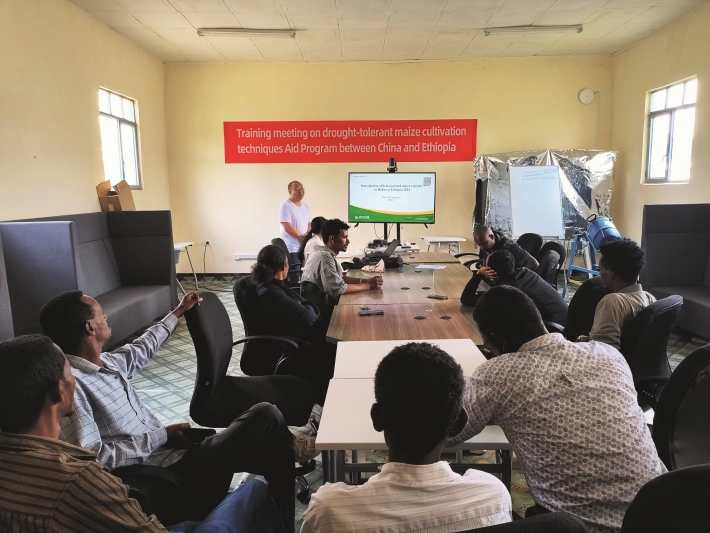|
||||||||||
| Home Top News Economy/Tech Culture/Sports China in Foreign Eyes Green Development Videos Intangible Cultural Heritages |
|
||||||||||
| Home Top News Economy/Tech Culture/Sports China in Foreign Eyes Green Development Videos Intangible Cultural Heritages |
| ChinAfrica |
| Seeds of Hope |
| Joint research and demonstration of drought-tolerant maize cultivation technology achieves success in Ethiopia |
| By Li Yin | VOL. 16 September 2024 ·2024-09-02 |

Local farmers, agricultural technicians and Chinese experts pose for a group photo at a demonstration field of Holeta in Ethiopia on 4 June (COURTESY)
Dubbed the essential “chips of agriculture,” seeds are the foundation of food security and agricultural modernisation. In 2021, China launched the Seed Industry Revitalisation Action Plan, listing the seed industry as a priority to secure the nation’s food safety. With increased investment and concerted efforts, China has made steady progress in research and innovation in the seed industry. Over the past three years, Chinese seeds have garnered significant international recognition. The seeds that have spurred prosperity in China’s rural areas are now being adopted by African countries through the Belt and Road Initiative (BRI).
Zero hunger, no poverty and good health and well-being are important goals of the United Nations 2030 Agenda for Sustainable Development. The eight major initiatives proposed by the 2018 Beijing Summit of Forum on China-Africa Cooperation, include supporting Africa in achieving general food security by 2030 by working with Africa to formulate and implement a programme of action to promote China-Africa cooperation on agricultural modernisation.

Holeta Municipality Communications O ce reports on the successful cultivation of drought-tolerant maize in Holeta on 4 June (COURTESY)
Cultivating new varieties
Over the years, with the joint support of the two governments and dedicated efforts by agricultural experts, China and Ethiopia have seen in-depth cooperation in agricultural technology. Numerous agricultural technicians and entrepreneurs have made remarkable contributions to food security, poverty reduction and sustainable agricultural development by launching new varieties and promoting efficient planting techniques.
Maize is one of the three main crops in Ethiopia with the highest yield and the largest total production, accounting for 30 percent of the country’s total grain output. It is primarily grown in the western, southwestern and eastern border regions, at elevations ranging from 1,500 to 2,200 metres.
With an aim to improve Ethiopia’s maize production, a four-year project on science and technology assistance to developing countries like Ethiopia was launched in October 2019 by the Institute of Biotechnology and Food Science of Hebei Academy of Agriculture and Forestry Sciences, in conjunction with Hebei Universe Agriculture Science and Technology Co. and the Institute of Agricultural Resources and Regional Planning of the Chinese Academy of Agricultural Sciences.
The project team conducted joint research and demonstrated drought-tolerant maize cultivation technology in Ethiopia in September 2020. A total of 40 maize varieties (hybrids) were brought to Ethiopia for further examination, of which six varieties showed excellent performance in local adaptability and drought resistance. Among them, the Xuntian 608 variety increased the yield by 38.7 percent compared to the local variety. The result of these hybrid varieties was praised by local farmers and technicians.
According to Liu Yueyang, head of this project, maize cultivation in Ethiopia is currently dominated by smallholder farmers practicing traditional rain-fed agriculture, which features low input and low output. Therefore, there is significant room for improvement in maize varieties and cultivation methods, highlighting maize as a staple food with substantial potential in Ethiopia.
Seboka Adugna, head of the Department of Plant Science at Holeta Polytechnic College, highly praised these hybrid maize varieties. These trial varieties have a growth period that is 20 to 40 days shorter than local varieties, and they exhibit stronger drought and disease resistance, along with higher yields. Notably, Zhongjin 368, Xuntian 608, and Zhongke Yu 505 are particularly well-suited for cultivation in high-altitude areas. He looks forward to expanding the demonstration planting area next year to further benefit local farmers.

Local technicians receive training on drought-tolerant maize cultivation techniques (COURTESY)
Complementary support
Besides the cultivation of hybrid maize seeds, a series of measures to support the development of agriculture in Ethiopia has also been carried out. In the process of agricultural cooperation, China shares its experience accumulated from long-term maize production with Ethiopia. Through technology demonstrations and dispatching senior agricultural technicians, Chinese experts share agricultural production technology and management experience with Ethiopians.
As part of the Seed Industry Revitalisation Action Plan, a visiting Chinese team held two agricultural technology training courses in Ethiopia for more than 100 participants, and invited five Ethiopian agricultural experts to China for training and exchange. In addition, the project team recommended Biru Alemu Chali, a researcher from the Bio and Emerging Technology Institute, to the Xishuangbanna Tropical Botanical Garden of Chinese Academy of Sciences to pursue a doctoral degree, which expanded the channels of talent cultivation and exchange.
“Studying in China has provided me with a unique educational experience, characterised by a strong emphasis on science and interactive teaching methods that foster critical thinking and collaboration. Moreover, the rapid advancements in science and technology in China have been incredibly inspiring. The collaborative atmosphere and access to cutting-edge research facilities have allowed me to explore new methodologies and ideas. I have had the opportunities to participate in various seminars and workshops, where I interacted with leading experts and fellow researchers from diverse backgrounds,” Chali told ChinAfrica.
The introduction of Chinese maize varieties, agricultural technologies and production models in Ethiopia has proven effective in transforming outdated cultivation methods, boosting productivity, and enhancing food security.
The implementation of the cooperation project has been lauded by government officials and local farmers alike, significantly strengthening the friendship between the two countries. It serves as a vivid embodiment of the strategic vision of the BRI.
At present, Ethiopia is at a crucial juncture in enhancing agricultural development and achieving food security, making China-Ethiopia agricultural science and technology cooperation more vital than ever, according to local government officials. Against the backdrop of sluggish economic recovery, if Ethiopia can address its food security challenges independently, it would make a significant contribution to global food security. The low level of agricultural technology application is a key challenge for Ethiopia. By sharing agricultural technology and fostering innovation in agricultural science, this project aims to address food security problems and reduce hunger in Ethiopia, thereby contributing to global food security and sustainable agricultural development.
| About Us | Contact Us | Advertise with Us | Subscribe |
| Copyright Beijing Review All rights reserved 京ICP备08005356号-5 京公网安备110102005860号 |